Helianthus
Helianthus (/ˌhiːliˈænθəs/)[3] is a genus of plants comprising about 70 species.[4][5] Except for three species in South America, all Helianthus species are native to North America and Central America. The common names "sunflower" and "common sunflower" typically refer to the popular annual species Helianthus annuus, whose round flower heads in combination with the ligules look like the sun.[6] This and other species, notably Jerusalem artichoke (H. tuberosus), are cultivated in temperate regions and some tropical regions as food crops for humans, cattle, and poultry, and as ornamental plants.[7] The species H. annuus typically grows during the summer and into early fall, with the peak growth season being mid-summer.[8]
| Sunflowers Temporal range: Eocene-recent[1] | |
|---|---|
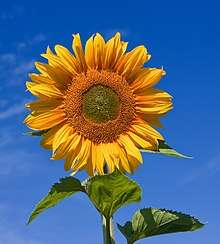 | |
| Common sunflower | |
| Scientific classification | |
| Kingdom: | Plantae |
| Clade: | Tracheophytes |
| Clade: | Angiosperms |
| Clade: | Eudicots |
| Clade: | Asterids |
| Order: | Asterales |
| Family: | Asteraceae |
| Subfamily: | Asteroideae |
| Supertribe: | Helianthodae |
| Tribe: | Heliantheae |
| Genus: | Helianthus L.[2] |
| Synonyms[2] | |
|
Harpalium (Cass.) Cass. | |
Perennial sunflower species are not as common in garden use due to their tendency to spread rapidly and become invasive. The whorled sunflower, Helianthus verticillatus, was listed as an endangered species in 2014 when the U.S. Fish and Wildlife Service issued a final rule protecting it under the Endangered Species Act. The primary threats are industrial forestry and pine plantations in Alabama, Georgia, and Tennessee. They grow to 1.8 m (6 ft) and are primarily found in woodlands, adjacent to creeks and moist, prairie-like areas.[9]
Description
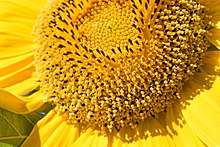
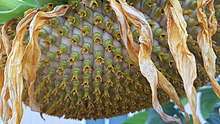
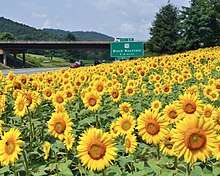
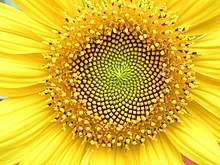
Origin
Sunflowers originate in the Americas. They were first domesticated in what is now Mexico and the Southern United States.[10][11] Domestic sunflower seeds have been found in Mexico, dating to 2100 BC. Native American people grew sunflowers as a crop from Mexico to Southern Canada.[11] In the 16th century the first crop breeds were brought from America to Europe by explorers.[11]
Morphology
Sunflowers are usually tall annual or perennial plants that in some species can grow to a height of 300 cm (120 in) or more. They bear one or more wide, terminal capitula (flower heads), with bright yellow ray florets at the outside and yellow or maroon (also known as a brown/red) disc florets inside. Several ornamental cultivars of H. annuus have red-colored ray florets; all of them stem from a single original mutant.[12] During growth, sunflowers tilt during the day to face the sun but stop once they begin blooming. This tracking of the sun in young sunflower heads is called heliotropism. By the time they are mature, sunflowers generally face east.[13] The movement of sunflowers through heliotropism happens as the sunflower follows the sun, the opposite side of the sunflower stem begins to accumulate growth hormones and this causes growth which redirects the sunflower.[14] The rough and hairy stem is branched in the upper part in wild plants but is usually unbranched in domesticated cultivars.
The petiolate leaves are dentate and often sticky. The lower leaves are opposite, ovate, or often heart-shaped. They are distinguished technically by the fact that the ray florets (when present) are sterile, and by the presence on the disk flowers of a pappus that is of two awn-like scales that are caducous (that is, easily detached and falling at maturity). Some species also have additional shorter scales in the pappus, and one species lacks a pappus entirely. Another technical feature that distinguishes the genus more reliably, but requires a microscope to see, is the presence of a prominent, multicellular appendage at the apex of the style. Further, the florets of a sunflower are arranged in a natural spiral.[15]
Variability is seen among the perennial species that make up the bulk of those in the genus. Some have most or all of the large leaves in a rosette at the base of the plant and produce a flowering stem that has leaves that are reduced in size. Most of the perennials have disk flowers that are entirely yellow, but a few have disk flowers with reddish lobes. One species, H. radula, lacks ray flowers altogether.
Helianthus species are used as food plants by the larvae of many lepidopterans. The seeds of H. annuus are used as human food.
Growth stages
The growth of a sunflower depends strictly on its genetic makeup and background.[16] Additionally, the season it is planted will have effects on its development. Sunflower development is classified by a series of vegetative stages and reproductive stages that can be determined by identifying the heads or main branch of a single head or branched head.[16]
Production
Fertilizer use
The Journal of Environmental Management has analyzed the impact of various nitrogen-based fertilizers on the growth of sunflowers. Ammonium nitrate was found to produce better nitrogen absorption than urea, which performed better in low-temperature areas.[17]
Production in Brazil
In Brazil, a unique system of production called the soybean-sunflower system is used: sunflowers are planted first, and then soybean crops follow, reducing idle periods and increasing total sunflower production and profitability. Sunflowers are usually planted in the extreme southern or northern regions of the country. Frequently, in the southern regions, sunflowers are grown in the beginning of rainy seasons, and soybeans can then be planted in the summer.[18] Researchers have concluded that the soybean-sunflower method of plantation could be further improved through changes in fertilizer use. The current method has been shown to have positive environmental impacts.[19]
| Countries | Million metric tonnes |
|---|---|
| Ukraine | 15 |
| Russia | 13 |
| European Union | 10 |
| Argentina | 4 |
| Turkey | 2 |
| Other | 9 |
Diversity
Accepted species
There are many species recognized in the genus:[21][22]
- Helianthus agrestis Pollard – southeastern sunflower – Florida Georgia
- Helianthus ambiguus Britt. – Wisconsin Michigan Ohio New York State
- Helianthus angustifolius L. – swamp sunflower – Texas + Florida north to southern Illinois + Long Island
- Helianthus annuus L. – common sunflower, girasol – most of United States + Canada
- Helianthus anomalus S.F.Blake – western sunflower – Nevada Utah Arizona New Mexico
- Helianthus argophyllus Torr. & A.Gray – silverleaf sunflower – Texas North Carolina Florida
- Helianthus arizonensis R.C.Jacks. – Arizona sunflower – Arizona New Mexico
- Helianthus atrorubens L. – purpledisk sunflower – Louisiana Alabama Georgia Florida South Carolina North Carolina Tennessee Kentucky Virginia
- Helianthus bolanderi A.Gray – serpentine sunflower – California Oregon
- Helianthus × brevifolius E.Watson – Texas Indiana Ohio
- Helianthus californicus DC. – California sunflower – California
- Helianthus carnosus Small – lakeside sunflower – Florida
- Helianthus ciliaris DC. – Texas blueweed – Washington California Arizona New Mexico Nevada Utah Texas Oklahoma Colorado Kansas Illinois Tamaulipas Coahuila Chihuahua Sonora
- Helianthus cinereus Small – Missouri Kentucky Indiana Ohio
- Helianthus coloradensis Cockerell – prairie sunflower – Colorado New Mexico
- Helianthus cusickii A.Gray – Cusick's sunflower – Washington Oregon California Idaho Nevada
- Helianthus debilis Nutt. – cucumberleaf Sunflower – Texas to Maine; Mississippi
- Helianthus decapetalus L. – thinleaf sunflower – eastern United States; Ontario Quebec
- Helianthus deserticola Heiser – desert sunflower – Arizona Nevada Utah
- †Helianthus diffusus Sims – Missouri†
- Helianthus dissectifolius R.C.Jacks. – Mexico
- Helianthus divaricatus L. – woodland sunflower or rough woodland sunflower – eastern United States; Ontario Quebec
- Helianthus × divariserratus R.W.Long Michigan Indiana Ohio Connecticut
- Helianthus × doronicoides Lam. – Texas Oklahoma Arkansas Missouri Iowa Minnesota Illinois Kentucky Indiana Ohio Pennsylvania Michigan New Jersey Virginia
- Helianthus eggertii Small – Alabama, Kentucky, and Tennessee
- Helianthus exilis A.Gray – California
- Helianthus floridanus A.Gray ex Chapm. – Florida sunflower – Louisiana Alabama Georgia Florida South Carolina North Carolina
- Helianthus giganteus L. – giant sunflower – eastern United States; most of Canada
- Helianthus glaucophyllus D.M.Sm – whiteleaf sunflower – Tennessee South Carolina North Carolina
- Helianthus × glaucus Small – scattered locales in southeastern United States
- Helianthus gracilentus A.Gray – slender sunflower – California
- Helianthus grosseserratus M.Martens – sawtooth sunflower – Great Plains, Great Lakes, Ontario Quebec
- Helianthus heterophyllus Nutt. – variableleaf sunflower – Coastal Plain Texas to North Carolina
- Helianthus hirsutus Raf. – hairy sunflower – central + Eastern United States, Ontario
- Helianthus × intermedius R.W.Long – intermediate sunflower – scattered locales in United States
- Helianthus laciniatus A.Gray – alkali sunflower – Arizona New Mexico Texas Coahuila Nuevo León
- Helianthus × laetiflorus Pers. – cheerful sunflower, mountain sunflower – scattered in eastern + central United States + Canada
- Helianthus laevigatus Torr. & A.Gray – smooth sunflower – Georgia South Carolina North Carolina Virginia Maryland West Virginia
- Helianthus lenticularis Douglas ex Lindl. California Texas
- Helianthus longifolius Pursh – longleaf sunflower – Alabama Georgia North Carolina
- Helianthus × luxurians (E.Watson) E.Watson – Great Lakes region
- Helianthus maximiliani Schrad. – Maximillian sunflower – much of United States + Canada
- Helianthus membranifolius Poir. – French Guiana
- Helianthus mollis Lam. – downy sunflower, ashy sunflower – Ontario, eastern + central United States
- Helianthus multiflorus L. – manyflower sunflower – Ohio
- Helianthus navarri Phil. – Chile
- Helianthus neglectus Heiser – neglected sunflower – New Mexico Texas
- Helianthus niveus (Benth.) Brandegee – showy sunflower – California Arizona; Baja California, Baja California Sur
- Helianthus nuttallii Torr. & A.Gray – western + central United States + Canada
- Helianthus occidentalis Riddell – fewleaf sunflower, western sunflower – Great Lakes region, scattered in southeastern United States
- Helianthus × orgyaloides Cockerell – Colorado Kansas
- Helianthus paradoxus Heiser – paradox sunflower – Utah New Mexico Texas
- Helianthus pauciflorus Nutt. – stiff sunflower – central United States + Canada
- Helianthus petiolaris Nutt. – prairie sunflower, lesser sunflower – much of United States + Canada
- Helianthus porteri (A.Gray) Pruski – Porter's sunflower – Alabama Georgia South Carolina North Carolina
- Helianthus praecox Engelm. & A.Gray Texas sunflower – Texas
- †Helianthus praetermissus – New Mexico sunflower – New Mexico†
- Helianthus pumilus Nutt. – little sunflower – Colorado Wyoming Montana Utah Idaho
- Helianthus radula (Pursh) Torr. & A.Gray – rayless sunflower – Louisiana Mississippi Alabama Georgia South Carolina Florida
- Helianthus resinosus Small – rescindot sunflower – Mississippi Alabama Georgia South Carolina North Carolina Florida
- Helianthus salicifolius A.Dietr. – willowleaf sunflower – Texas Oklahoma Kansas Missouri Illinois Wisconsin Ohio Pennsylvania New York State
- Helianthus sarmentosus Rich. – French Guiana
- Helianthus scaberrimus Elliott – South Carolina
- Helianthus schweinitzii Torr. & A.Gray – Schweinitz's sunflower – South Carolina North Carolina
- Helianthus silphioides Nutt. – rosinweed sunflower – Lower Mississippi Valley
- Helianthus simulans E.Watson – muck sunflower – southeastern United States
- Helianthus smithii Heiser – Smith's sunflower – Alabama Georgia Tennessee
- Helianthus speciosus Hook. – Michoacán
- Helianthus strumosus L. – eastern + central United States + Canada
- Helianthus subcanescens (A.Gray) E.Watson – Manitoba, north-central United States
- Helianthus subtuberosus Bourg.
- Helianthus tuberosus L. – Jerusalem artichoke, sunchoke, earth-apple, topinambur – much of United States + Canada
- Helianthus verticillatus Small – whorled sunflower – Alabama Georgia Tennessee
Formerly included
The following species were previously included in the genus Helianthus.[21]
- Flourensia thurifera (Molina) DC. (as H. thurifer Molina)
- Helianthella quinquenervis (Hook.) A.Gray (as H. quinquenervis Hook.)
- Helianthella uniflora (Nutt.) Torr. & A.Gray (as H. uniflorus Nutt.)
- Pappobolus imbaburensis (Hieron.) Panero (as H. imbaburensis Hieron.)
- Viguiera procumbens (Pers.) S.F.Blake (as H. procumbens Pers.)
Gallery
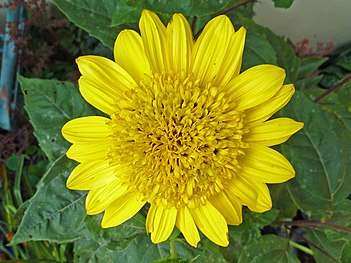 Helianthus decapetalus
Helianthus decapetalus
"Plenus"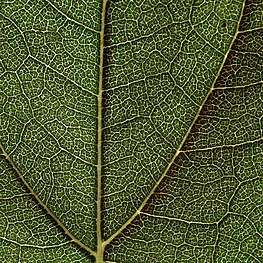 Sunflower leaf structure
Sunflower leaf structure.jpg) Prairie sunflower
Prairie sunflower
(H. petiolaris)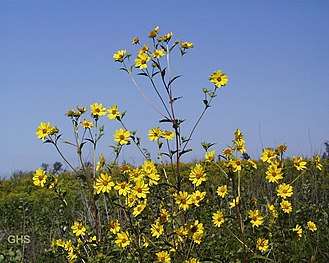 Giant sunflower
Giant sunflower
(H. giganteus)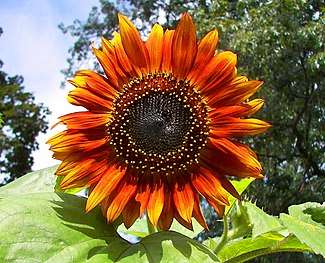 Red sunflower
Red sunflower.jpg) Helianthus
Helianthus
'Strawberry Blonde'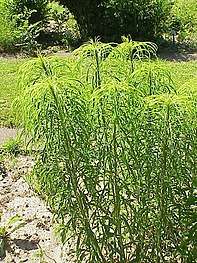 Willowleaf sunflower
Willowleaf sunflower
(H. salicifolius)- Sunflower bud
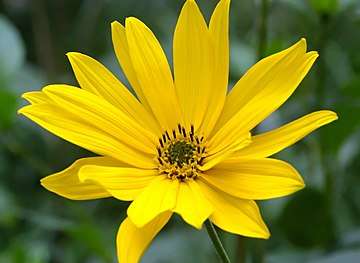 Jerusalem artichoke
Jerusalem artichoke
(H. tuberosus)- Leaves of sunflower plant
- Rear view of sunflower head
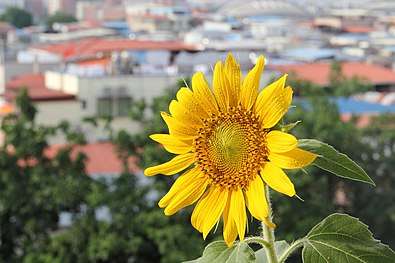 H. annuus
H. annuus- H. laetiflorus

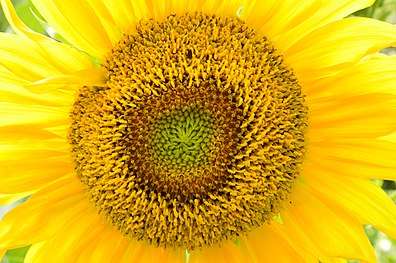 Close-up of a sunflower
Close-up of a sunflower
See also
- Spiral in the sunflower
- Fermat's spiral
- Phyllotaxis
- Stegocintractia junci
References
- "Early sunflower family fossil found in South America". Phys.org. Lin Edwards.
- "Helianthus". Germplasm Resources Information Network (GRIN). Agricultural Research Service (ARS), United States Department of Agriculture (USDA). Retrieved 2011-02-22.
- Sunset Western Garden Book. Leisure Arts. 1995. pg. 606–607.
- Schilling, Edward E. (2006). "Helianthus". In Flora of North America Editorial Committee (ed.). Flora of North America North of Mexico (FNA). 21. New York and Oxford – via eFloras.org, Missouri Botanical Garden, St. Louis, MO & Harvard University Herbaria, Cambridge, MA.
- "Sunflower Production". North Dakota State University. Archived from the original on August 18, 2016. Retrieved July 12, 2016.
- Shorter Oxford English Dictionary, 6th ed. United Kingdom: Oxford University Press. 2007. p. 3804. ISBN 978-0-19-920687-2.
- RHS A-Z Encyclopedia of Garden Plants. United Kingdom: Dorling Kindersley. 2008. p. 1136. ISBN 978-1-4053-3296-5.
- "Conservation Plant Characteristics - Helianthus annuus L. common sunflower HEAN3". USDA - Natural Resources Conservation Service. Retrieved April 1, 2019.
- Remillard, Ashley (August 4, 2014) "U.S. Fish and Wildlife Service Issues Final Rule Protecting Three Flowers" Archived 2014-08-12 at the Wayback Machine Endangered Species Law and Policy Blog, Nossaman LLP
- Genetics, Genomics and Breeding of Sunflower, (CRC Press, 8 Apr 2010) edited by Jinguo Hu, Gerald Seiler, C. Kole, page 8
- Plant Evolution and the Origin of Crop Species, By James F. Hancock (CABI, 2012), page 188
- Heiser, C.B. The Sunflower. University of Oklahoma Press. 1981.
- "How Does a Sunflower Move?". Home Guides – SF Gate. Archived from the original on 2014-10-18.
- "How Sunflowers Move to Follow the Sun". UC Berkeley Rausser College of Natural Resources. Retrieved 2020-05-01.
- Ben Sparks. "Geogebra: Sunflowers are irrationally pretty".
- Berglund, Duane. "Sunflower Production". ag,ndsu. NDSU Extension Service and N.D. Agricultural Experiment Station. Retrieved Feb 7, 2019.
- Spinelli, D; Bardi, L; Fierro, A; Jez, S; Basosi, R (2017). "Environmental analysis of sunflower production with different forms of mineral nitrogen fertilizers" (PDF). The International Journal of Life Cycle Assessment. Journal of Environmental Management. 22 (4): 492–501. doi:10.1007/s11367-016-1089-6.
- Castro, C.; Leite, Regina. "Main aspects of sunflower production in Brazil". ProQuest 2036361008. Cite journal requires
|journal=(help) - Mastuura, M. I. S. F.; Dias, F. R. T.; Picoli, J. F.; Lucas, K. R. G.; Castro, C.; Hirakuri, M. H. (2017). "Life-cycle assessment of the soybean-sunflower production system in the Brazilian Cerrado" (PDF). The International Journal of Life Cycle Assessment. 22 (4): 492–501. doi:10.1007/s11367-016-1089-6.
- "Major producer countries of sunflower seed, 2018/2019". Statista. Retrieved 2018-08-10.
- "Helianthus". The Plant List. Missouri Botanical Garden. Royal Botanic Gardens, Kew.CS1 maint: others (link)
- "Helianthus". County-level distribution maps from the North American Plant Atlas (NAPA). Biota of North America Program (BONAP). 2014.
| Wikimedia Commons has media related to Helianthus. |
| Wikispecies has information related to Helianthus |